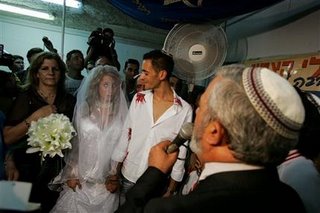
by Michaela Cancela-Kieffer Thu Jul 20, 11:14 AM ETHAIFA, Israel (AFP) - The Bahai believe that Moses, Christ, and Mohammed are all messengers of God and unlike their holy city of Haifa their faith in coming world peace is unshaken by Hezbollah’s rockets.Dozens of Hezbollah rockets have exploded in this port city, 40 kilometres (25 miles) from the Lebanese border, since the militia last week captured two Israeli soldiers andIsrael responded with a massive bombardment.Streets may be deserted, but the rockets, which killed eight railway workers in Haifa on Sunday, matter little to 100 pilgrims from the Bahai faith who arrived on Monday for a nine-day visit.The Bahai, who believe in “the fundamental unity of all the great religions”, was founded inIran’ in the 19th century by their prophet, Baha’u'llah.Haifa is home to the Bahais’ governing body, the sparkling white Universal House of Justice, as well as the shrine of the Bab, he who announced the coming of Bahaullah.His remains are housed in a splendid hillside mausoleum overlooking Haifa bay, amid spectacular and well-manicured terraced gardens, which the movement says was visited by half a million people in 2005.British couple Gillian and Anthony Henderson have come on pilgrimage from their home in Vancouver, Canada.Anthony is easy to spot in the near-deserted city, wearing a Scottish kilt, indicative of the diversity of the varied Bahai cultures — spanning 75 nationalities and several million followers — so says the movement.“We decided we would come because we waited many, many years,” says Anthony. “You have to apply (to come here on pilgrimage) most of the time you wait for five or six years.”“It’s hard to put it into words, it is the most holy place in the world for us,” says Gillian. “To be able to visit is the biggest blessing. We have to do it at least once in our life.”The Bahai, banned and persecuted in Iran, are not involved in politics, but have great affection for theUnited Nations’ United Nations. Their founder banned proselytizing in Israel, the Jewish state.Albert Lincoln, the Bahais’ “secretary general” as the movement has no clergy, will not comment on the current conflict but explains his community has “a message of peace and unity for the human race.”Gillian says all the pilgrims prayed together on Monday.“It was very emotional considering the situation, we prayed very much for mankind and peace and we hoped for a peaceful resolution for all people.”The British couple, who have left six children at home, have not been in a conflict zone before and have had to adapt to a life of air raid sirens and rocket blasts.Some 700 volunteers and 150 employees work in the luxurious complex, built with donations from the faithful, all white marble and Persian carpets.Followers believe in the coming unification of humanity even if the world must first go through difficult times, such as those that started with the conflict between Israel and Hezbollah on July 12.“The world is getting darker and darker, but we have a more long-term vision,” says French architect Daniel Caillaud who has lived in Haifa since 1988.During a visit to the pristine gardens “whose beauty shows the optimism of the Bahais” according to Indian follower Elisa Rasiwala, 53, the air raid siren shrieks once more, heralding the next rocket attack on Haifa.“Our holy places are currently in the middle of the world in every sense. This is the eye of the storm,” says the 59-year-old. “There’s no doubt. The future is promising.”
Comments (0)


